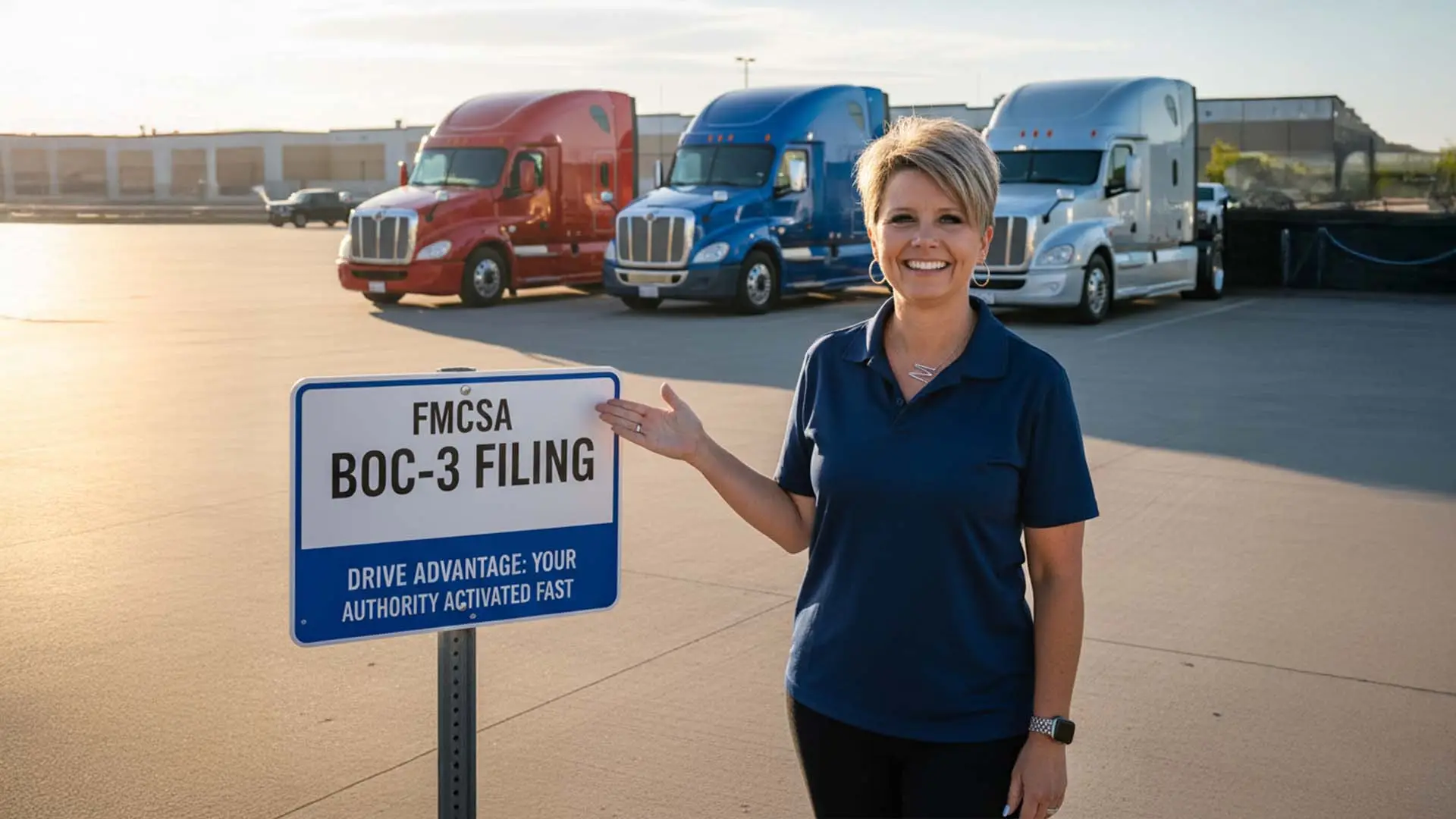Every year, thousands of people are killed in crashes involving large trucks. As a professional truck driver, you can help reduce these risks by following proven safety tips for semi-truck drivers and maintaining FMCSA safety compliance on every trip. Large trucks have unique challenges – from huge blind spots to long stopping distances – so it’s critical to plan for safety on every trip. Below are ten essential tips to keep you and others safe on the road.
1. Check Your Blind Spots
Large Blind Spots: Semi-trucks have massive “No Zone” blind spots along the sides, rear, and even directly in front of the cab. Other vehicles can easily disappear from your mirrors in these areas, so stay vigilant about checking mirrors frequently. In fact, experts recommend glancing at your mirrors every 8–10 seconds to watch for cars entering your blind zones. Continuously scan ahead about 15 seconds down the road (roughly a quarter mile on highways, or one to two city blocks) so you can spot traffic slowdowns, work zones, or other hazards early. If you lose sight of a vehicle in your mirrors, assume it’s in a blind spot and proceed with caution until you can account for it.
2. Be Aware of Long Stopping Distances
Driving a 40-ton rig means you need much more distance to stop than a passenger car. In fact, a fully-loaded truck may require the length of up to two football fields (600+ feet) to come to a complete stop in ideal conditions. Always maintain extra following distance and anticipate stops well in advance. Avoid speeding, especially when roads are wet or icy – driving too fast for conditions or not slowing down for curves and ramps dramatically raises the risk of rollovers and crashes. Remember that your truck’s weight and momentum are tremendous; give yourself ample space and time to slow down safely. Following FMCSA safety compliance practices helps reduce the risk of preventable accidents.
3. Make Wide Turns Carefully
Maneuvering a long tractor-trailer through turns requires special care. Always plan for the off-tracking of your trailer – the rear wheels will track inside the path of your cab, so you need extra space. Swing wide only when necessary and watch your mirrors to ensure no vehicles or pedestrians are caught in the turning path. Signal well in advance of the turn to warn others (more on signaling below). Take turns slowly and deliberately. If making a tight right turn, for example, check that no one is trying to squeeze along your right side. Patience is key: if you must momentarily occupy an adjacent lane or pause to complete a safe turn, do so — rushing a wide turn can lead to running over curbs, poles, or other vehicles. Large trucks need extra space and time for turns, so execute them cautiously and confidently.
4. Always Buckle Up
Seat belts save lives in any vehicle, and big rigs are no exception. Wear your seat belt every time you drive or ride in a truck. Tragically, not wearing a seat belt is a major contributor to fatal crash outcomes among truck drivers. Industry data show that nearly two-thirds of truck drivers killed in crashes were not buckled up at the time. A seat belt keeps you inside the cab, in your seat, and in control during a crash or sudden stop, which greatly increases your chances of surviving. In a rollover or collision, being ejected from the truck can be deadly – belts prevent that. Buckling up also helps you maintain control of your vehicle during violent maneuvers by holding you in place. It’s not just about compliance with the law (which requires commercial drivers to buckle up) – it’s about making sure you make it home safely to your family.
5. Drive at a Safe Speed
Speeding in a semi-truck is extremely dangerous. The size and weight of your rig mean it takes longer to brake and it hits with far greater force in a crash. High speed also exacerbates challenges in handling – for example, heavy trucks gain momentum downhill quickly and can struggle to stop or turn in time. According to the FMCSA, speeding is a major contributor to crashes, injuries, and fatalities on our roadways. Always obey the speed limit and drive defensively for road conditions. That might mean driving below the posted limit if weather or traffic warrants it. Manage your speed on downgrades by gearing down and using engine brakes; don’t rely on brakes alone or you risk overheating them. Likewise, take curves and highway ramps slowly – approach bends at a safe speed to prevent tipping or losing control. Remember, a professional driver maintains safe speeds to protect everyone on the road.
6. Stay Focused and Avoid Distracted Driving
Driving an 80,000-pound truck demands your full attention. Distracted driving is a leading cause of crashes on America’s roads, so do everything possible to stay focused. First, never text or use a handheld phone while driving – not only is it illegal for commercial drivers, but taking your eyes off the road for even a few seconds at highway speeds can be catastrophic. If you must make a call, use a hands-free device and one-touch dialing, as required by law. Avoid other distractions like eating, adjusting a GPS, or reading maps while moving. Plan breaks into your schedule so you can attend to those needs safely off the road. Equally important, manage fatigue: get plenty of rest and never drive when you’re drowsy, overly fatigued, feeling ill, or under the influence of any medication that causes drowsiness. Long hours and monotonous highways can lull even experienced drivers – if you start to feel tired, pull over at a safe spot and rest. Staying alert and focused behind the wheel at all times is absolutely vital to safe trucking.
7. Always Use Your Signal
Proper signaling is a simple but critical habit for professional drivers. Your truck is large and not as nimble as smaller vehicles, so other drivers need to know well ahead of time what you intend to do. Signal early and clearly before lane changes, turns, or merges – give motorists plenty of time to notice your blinker and adjust. Likewise, tap your brakes a few times to flash your brake lights when slowing down, if possible, to warn those behind you. Using your signals is not only courteous, it’s essential to prevent surprises on the road. If you must pull off due to an emergency or breakdown, get fully out of the travel lanes if you can, and immediately activate your flashers. As soon as it’s safe, set up reflective triangles or road flares behind your truck to alert oncoming traffic. This will give other drivers advance warning so they can change lanes or slow down. In sum, always communicate your intentions – it greatly reduces the risk of collisions by keeping surrounding drivers informed.
8. Maintain Your Vehicle
Safe driving isn’t just about what you do on the road – it starts before you even turn the key. Always perform a thorough pre-trip inspection of your truck and trailer. Pay special attention to critical components like brakes and tires, since failures in these systems can be catastrophic. Defective equipment plays a role in many truck crashes, and keeping up with FMCSA MCS-150 compliance ensures your maintenance and records stay current: for example, one study found that 42% of crash-involved trucks had brake defects, and trucks with serious brake problems had triple the crash risk compared to those without. Catching issues like worn brake pads, air leaks, or under-inflated tires during an inspection can literally save lives. Also ensure your load is balanced and properly secured before departure. An unbalanced or poorly secured cargo can shift in transit and cause a rollover or loss of control. In fact, the FMCSA’s cargo securement regulations were implemented to reduce accidents caused by cargo shifting or falling from trucks. Use the proper tie-downs, check that doors and tarps are tight, and remove any loose debris that could fly off. By keeping your equipment in top shape and your freight secure, you greatly reduce the chance of a preventable crash due to mechanical failure or load issues.
9. Plan Your Trip in Advance
Before you hit the road, take time to plan your route and schedule. Check the weather forecast and road conditions for your entire trip — especially during winter months when tire chain laws by state and chaining up procedures for trucks may apply – knowing about heavy rain, snow, high winds, or construction zones ahead of time lets you prepare or adjust your route. Have a plan for detours or heavy traffic areas, and give yourself enough time so you’re not forced to rush. Importantly, use truck-specific navigation tools or maps when planning routes. Standard car GPS apps and map services may not alert you to low bridges, weight-restricted roads, or other hazards for big rigs. Many accidents have occurred because a trucker blindly followed a car GPS into an impassable route (for example, striking a low overpass). Don’t let that be you – if you’re unfamiliar with a route, do your homework. Use a commercial GPS that accounts for your vehicle’s height and weight, and double-check permits or restrictions on any unusual roads. If an unexpected detour arises, be extremely cautious and seek guidance (such as posted truck route signs or calling dispatch) if you’re unsure about clearance. By planning trips in advance, you can avoid surprises, stay on schedule, and ensure you only drive on appropriate, safe roads for your truck.
10. Practice Work Zone Safety
Work zones are especially dangerous for truck drivers and road workers alike, so extra caution is mandatory. These areas often feature lane shifts, narrowed lanes, sudden stops, uneven pavement, and workers on or near the roadway – a recipe for trouble if you’re not prepared. Sadly, fatal work zone crashes have been on the rise in recent years. In 2023 alone, 898 people were killed in work zone crashes and about 40,000 were injured. Overall, work zone deaths have increased 53% since 2010, underscoring the need for vigilance. When approaching and driving through construction zones, follow these safety steps:
- Slow down and maintain extra following space. Reduce your speed well in advance and be ready to stop suddenly. Rear-end collisions are common in work zones, so keep a safe distance from any vehicle ahead of you.
- Obey all work zone signs and signals. Pay close attention to posted speed reductions, flaggers, arrow boards, and lane closure signs. Follow merging instructions early – don’t barrel to the lane drop at the last second.
- Stay alert and scan ahead. Traffic patterns can change quickly in work zones. Watch for brake lights and lane shifts up ahead, and be mindful of vehicles beside you that might swerve or enter your blind spots unexpectedly.
- Watch out for road workers. Keep a sharp eye for construction personnel and equipment. They may be only feet away from your path, sometimes moving in and out of lanes. If you see workers or flag crews, be prepared to stop and follow their directions.
By respecting work zone warnings and using extreme caution, you protect both yourself and the roadway crews working to improve our highways. No delivery schedule is worth a life – drive safe and patient through every work zone.



